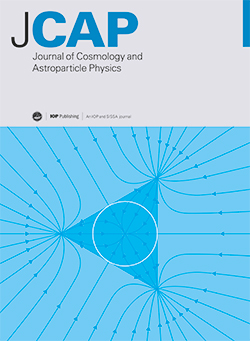利用深度学习进行预热
IF 5.3
2区 物理与天体物理
Q1 ASTRONOMY & ASTROPHYSICS
Journal of Cosmology and Astroparticle Physics
Pub Date : 2024-08-22
DOI:10.1088/1475-7516/2024/08/031
引用次数: 0
摘要
我们将深度学习技术应用于一个膨胀后模型的晚期湍流机制,在这个模型中,一个真实的标量 "流入 "场和标准模型 "希格斯双特 "之间存在可重归一化的耦合。膨胀后,膨胀子通过三线性耦合衰变为希格斯粒子,希格斯粒子场随后通过其 SU(2)×U(1) 轨则相互作用与轨则玻色子热化。根据三线性相互作用和希格斯自耦合的强度,希格斯的有效质量平方可能变为负值,从而导致希格斯粒子的超速产生。这些产生的希格斯粒子将与规玻色子共享能量,可能表明热化。由于该模型涉及不同的非微扰效应,因此有必要采用数值和半经典技术。然而,模拟需要耗费大量时间和计算资源,这取决于所使用的模型。特别是当引入 SU(2) 轨则相互作用时,由于轨则场通过重散射过程重新分配粒子能量,导致大量破坏模拟稳定性的 UV 模式,这一点变得非常明显。这就需要非常小的晶格间距,从而导致超长的模拟运行时间。此外,根据波动力理论,预热动力学的后期行为表现出一种普遍形式。因此,我们使用 CNN-LSTM(结合长短期记忆的卷积神经网络)时间序列分析法分析粒子数量流动的模式并预测未来行为。通过这种方法,我们可以在时间和计算资源方面减少对模拟的依赖。本文章由计算机程序翻译,如有差异,请以英文原文为准。
Preheating with deep learning
We apply deep learning techniques to the late-time turbulent regime in a post-inflationary model where a real scalar inflaton field and the standard model Higgs doublet interact with renormalizable couplings between them. After inflation, the inflaton decays into the Higgs through a trilinear coupling and the Higgs field subsequently thermalizes with gauge bosons via its SU(2)×U(1) gauge interaction. Depending on the strength of the trilinear interaction and the Higgs self-coupling, the effective mass squared of Higgs can become negative, leading to the tachyonic production of Higgs particles. These produced Higgs particles would then share their energy with gauge bosons, potentially indicating thermalization. Since the model entails different non-perturbative effects, it is necessary to resort to numerical and semi-classical techniques. However, simulations require significant costs in terms of time and computational resources depending on the model used. Particularly, when SU(2) gauge interactions are introduced, this becomes evident as the gauge field redistributes particle energies through rescattering processes, leading to an abundance of UV modes that disrupt simulation stability. This necessitates very small lattice spacings, resulting in exceedingly long simulation runtimes. Furthermore, the late-time behavior of preheating dynamics exhibits a universal form by wave kinetic theory. Therefore, we analyze patterns in the flow of particle numbers and predict future behavior using CNN-LSTM (Convolutional Neural Network combined with Long Short-Term Memory) time series analysis. In this way, we can reduce our dependence on simulations by orders of magnitude in terms of time and computational resources.
求助全文
通过发布文献求助,成功后即可免费获取论文全文。
去求助
来源期刊

Journal of Cosmology and Astroparticle Physics
地学天文-天文与天体物理
CiteScore
10.20
自引率
23.40%
发文量
632
审稿时长
1 months
期刊介绍:
Journal of Cosmology and Astroparticle Physics (JCAP) encompasses theoretical, observational and experimental areas as well as computation and simulation. The journal covers the latest developments in the theory of all fundamental interactions and their cosmological implications (e.g. M-theory and cosmology, brane cosmology). JCAP''s coverage also includes topics such as formation, dynamics and clustering of galaxies, pre-galactic star formation, x-ray astronomy, radio astronomy, gravitational lensing, active galactic nuclei, intergalactic and interstellar matter.
 求助内容:
求助内容: 应助结果提醒方式:
应助结果提醒方式:


